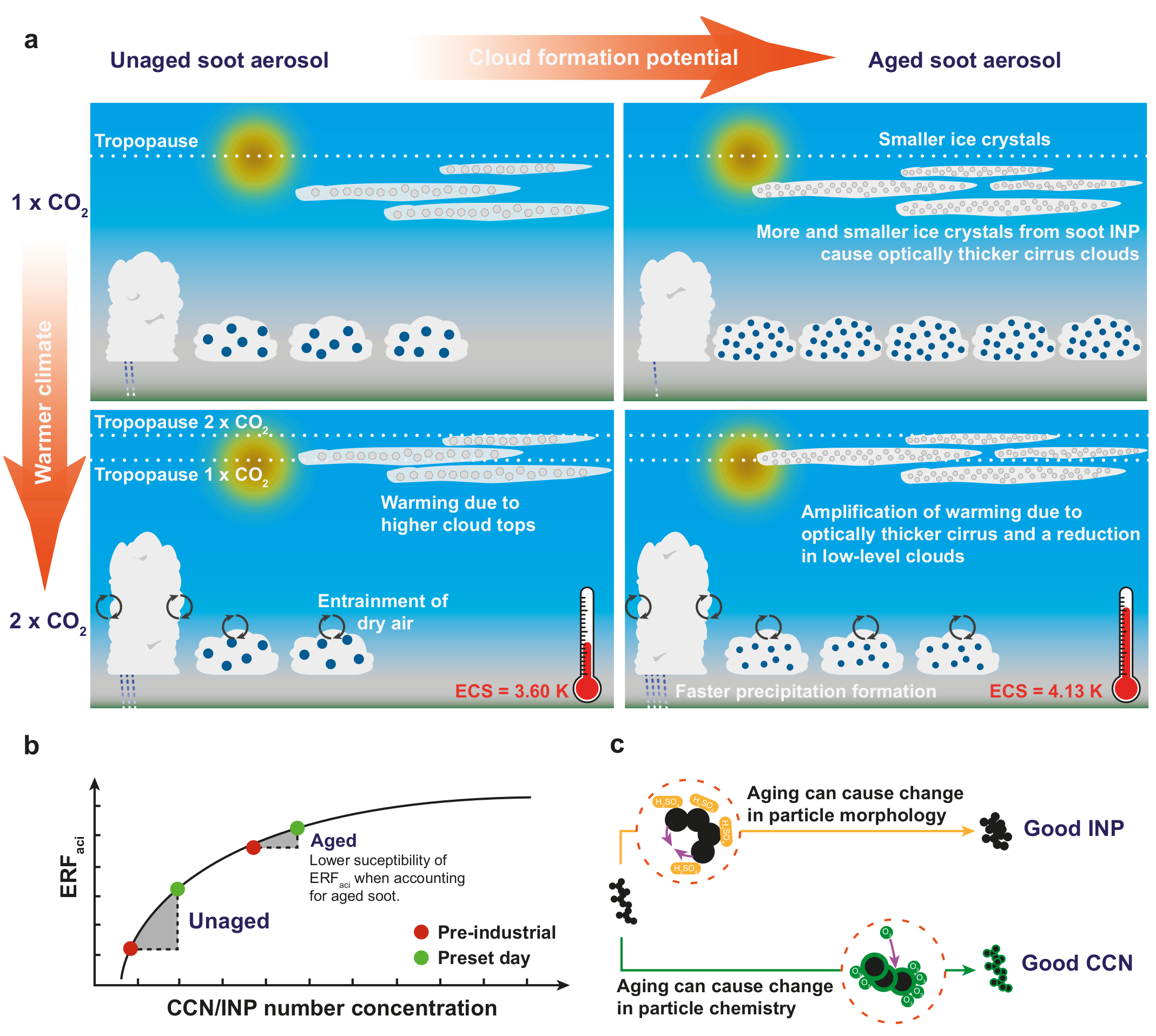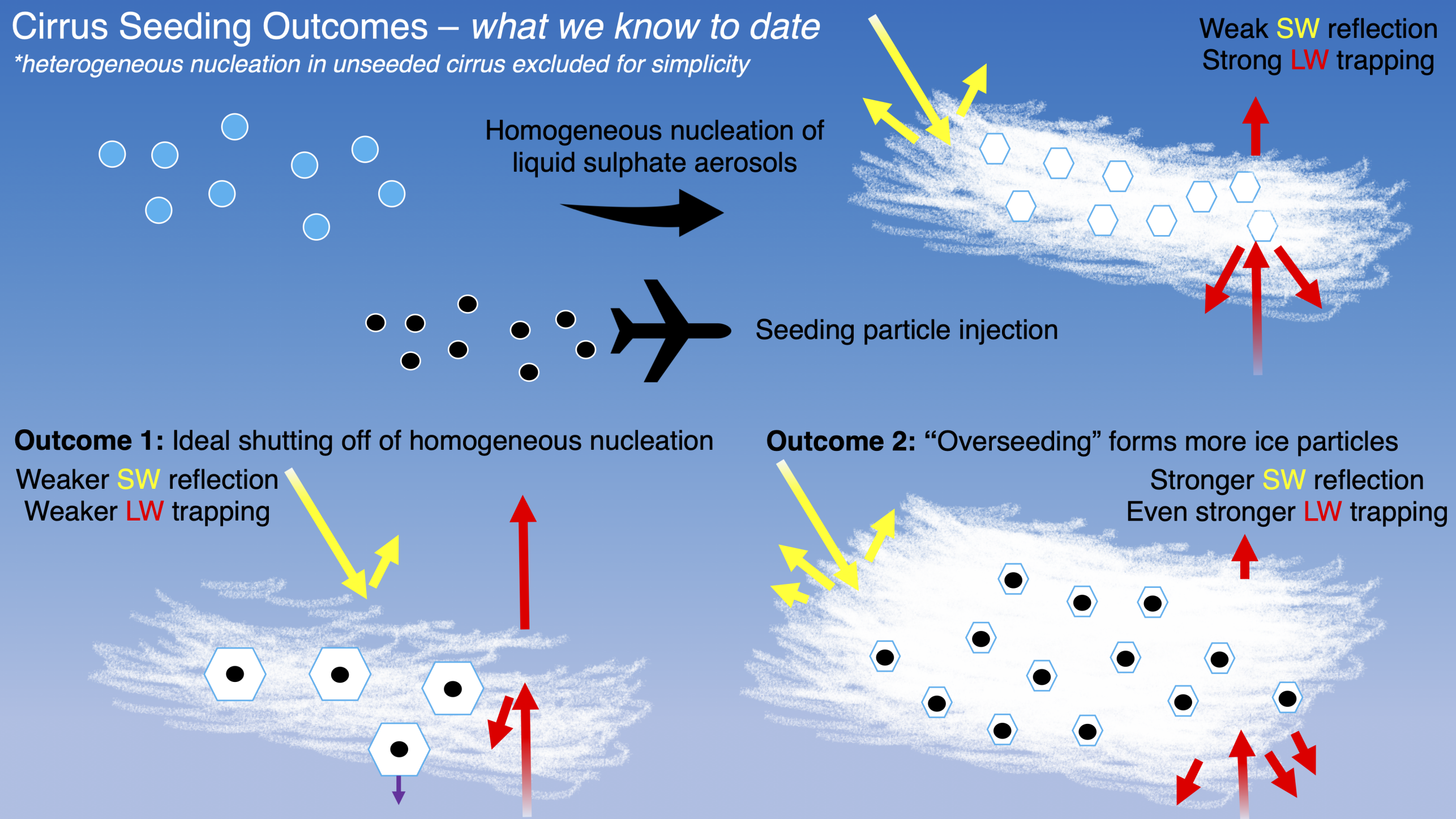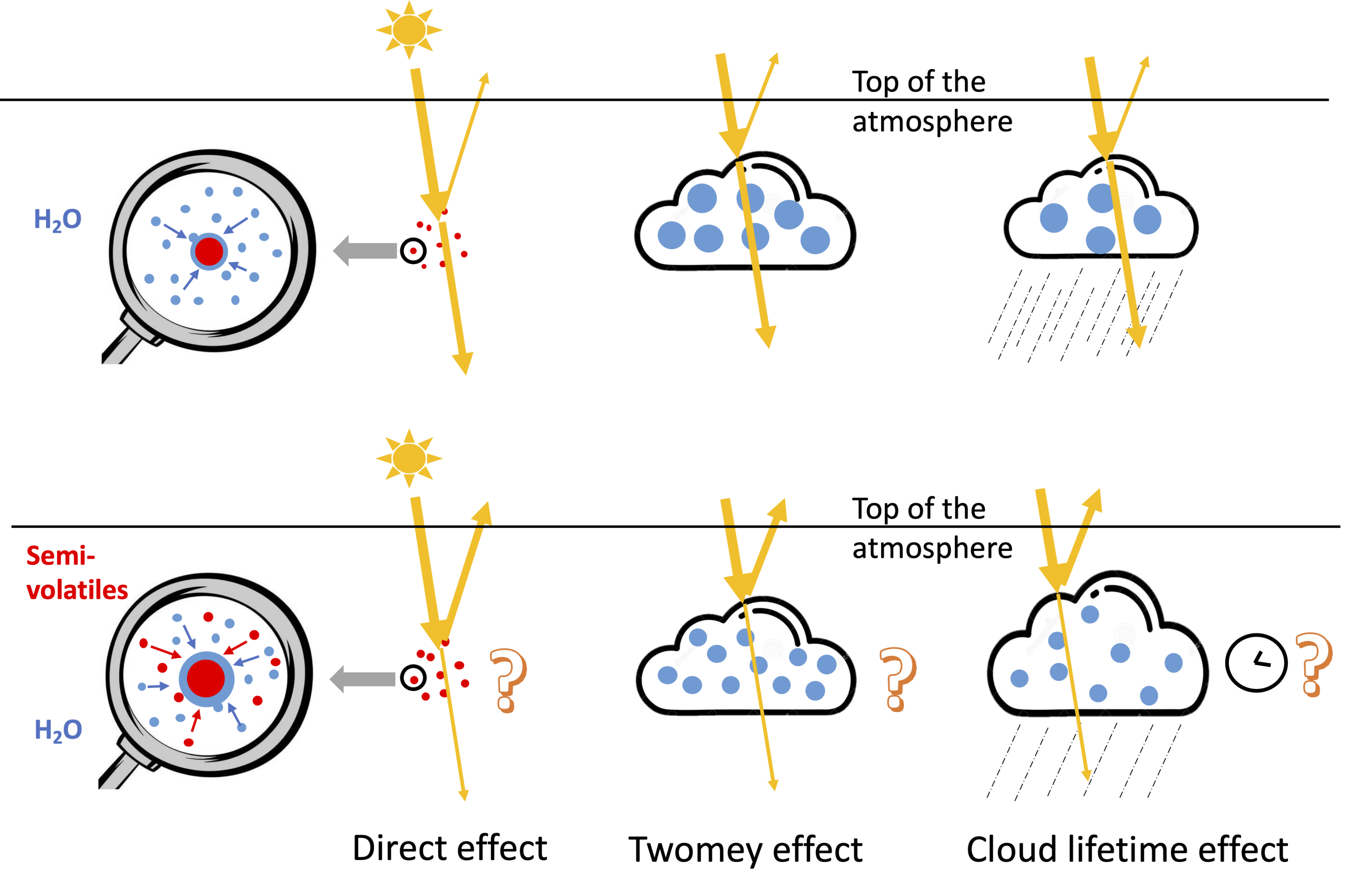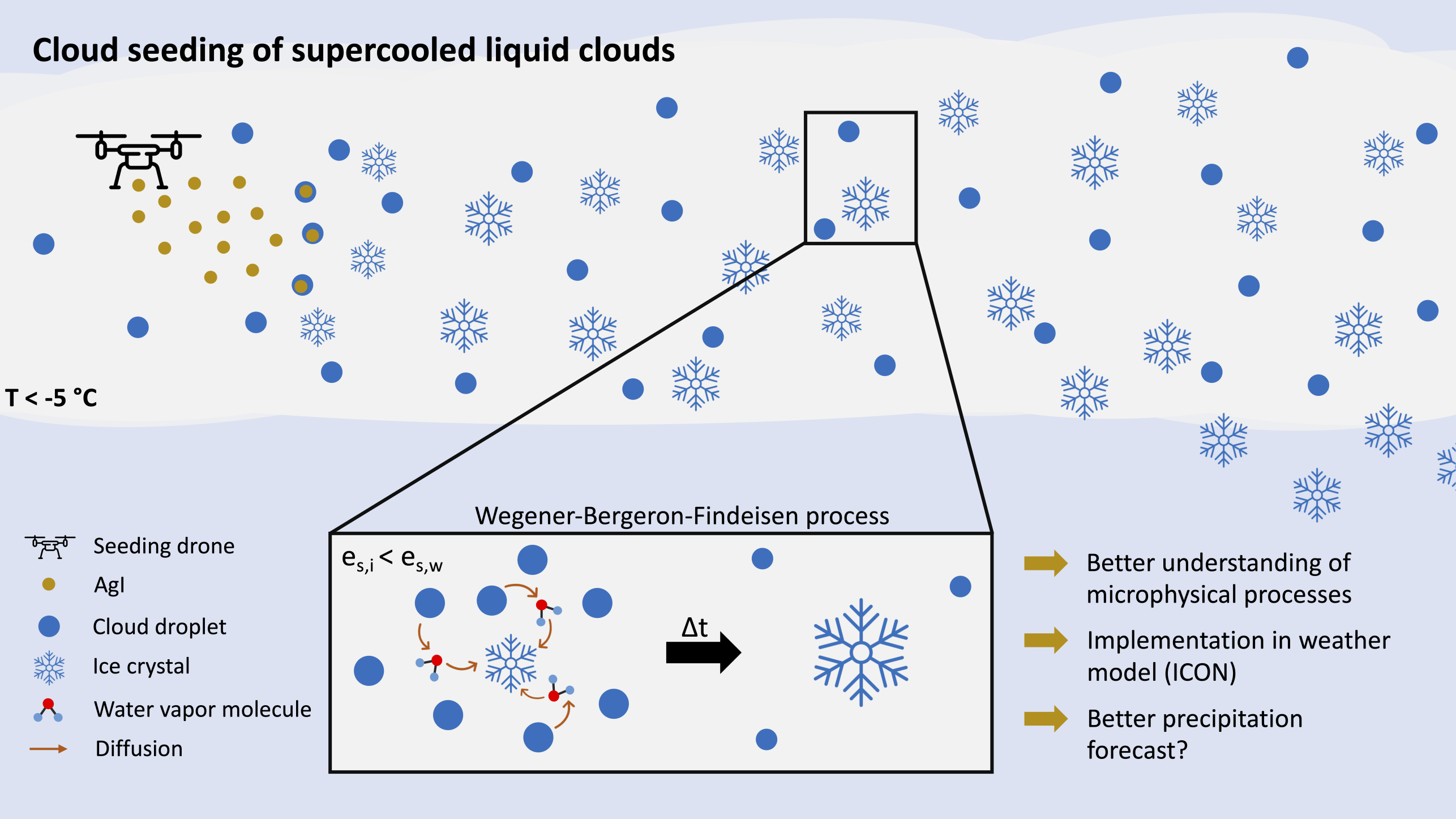Aerosol-Cloud Interactions (ACI)
ACI in stratocumulus clouds
Although all cloud types are affected by aerosols, subtropical marine stratocumulus clouds are of particular relevance to the study of aci because of their wide spatial coverage and sensitivity to aerosol injections. Numerous studies have used satellite data to unveil the causal relationship between aerosol concentration and cloud radiative properties in this type of clouds. However, because of masking by clouds, satellites cannot observe true in-cloud aerosol concentrations. Instead, satellites retrieve Aerosol Optical Depth (AOD) close to the cloud, but not in the cloud (collocation problem). It is difficult to estimate how much the use of such proxies blurs out the strength of the true causal effect of aerosols on cloud properties. This project will focus on developing a new aerosol proxy from geostationary satellite data, using a supervised machine learning model trained on high-resolution model data (ICON-HAM) that are not impacted by the collocation problem.
This project is part of the EU project iMIRACLI (external pagewww.imiracli.eucall_made). For more information, please contact Emilie Fons ().
Aging of soot due to ozone and sulfuric acid
Soot is considered the second most important anthropogenic climate forcing agent after carbon dioxide. Based on lab measurements in our group (Friebel et al., 2019; Mahrt et al., 2020) soot aging due to ozone and due to sulfuric acid has been parameterized and the impact investigated in the global aerosol-climate model ECHAM6.3-HAM2.3. The soot aging by ozone increases the ability of the soot particles to act as cloud condensation nuclei and the aging by sulfuric acid increases their ability to act as ice nucleating particles. The resulting increase in cloud droplet and ice crystal number concentrations leads to thicker low and high clouds and reduces the negative shortwave effective radiative forcing due to ACI and aerosol-radiation interactions by 0.2 to 0.3 W m−2. Also cloud feedbacks are amplified by these soot aging mechanisms when the carbon dioxide content of the atmosphere doubles compared to the pre-industrial area, leading to an additional warming.
external pagehttps://www.youtube.com/watch?v=otRgiWASZs0call_made
For more information, please contact Ulrike Lohmann () or David Neubauer ().

Constrain cirrus cloud drivers
Aerosols can significantly influence the formation pathways and microphysical properties of cirrus clouds. Due to the high spatio-temporal variability and non-linear dependence on meteorological drivers like temperature, updraft velocities, and aerosol environment it remains uncertain how cirrus clouds will respond to climate change (Boucher et al.,2013; Gryspeerdt et al., 2018). One part of this research is to quantify the effects of the individual cirrus cloud drivers by analyzing remote sensing observations from the CALIPSO and CloudSat satellites using machine learning methods.
Furthermore, we will analyze the impact of volcanic aerosol on cirrus clouds. This is of particular scientific interest since it provides the unique opportunity to study the effect of a significant amount of externally induced sulfate aerosols or their precursor gases on cirrus clouds in real-world data. The gained knowledge is not only helpful for understanding how aerosols control cirrus cloud formation but also for assessing climate intervention methods that aim to increase Earth’s albedo by artificially inducing ice nucleating particles into the stratosphere (Mitchell and Finnegan, 2009).
This project is part of the EU project iMIRACLI (external pagewww.imiracli.eucall_made). For more information, please contact Kai Jeggle ().

Evaluation of a hail damage mitigation campaign over the Swiss plateau
Hail suppression by seeding clouds with adding Ice Nucleating Particles (INPs) has been practiced in many parts of the world for several decades. This practice, while widespread, remains controversial and there has been no clearly defined demonstration (mainly) of the magnitude of positive effects. The reason is that hailstorms are rare events that consist of many non-linear, interacting processes. The main idea of this methodology is that providing more INPs is expected to increase the number of hail embryos in the clouds, amplifying in this way the competition for the available supercooled water. This study evaluates the hail damage mitigation campaign over the Swiss plateau which was conducted by the Baloise insurance using the regional weather and climate model Consortium for Small-Scale Modelling COSMO and polarimetric radar measurements. The seeding using as main seeding agent silver iodide (AgI) was operated by a small plane (Cessna). Exploiting the available data from the last three consecutive hail seasons, this study aims to detect the seeding signal, distinguishing it from the natural variability of hailstorms.
For more information, please contact Nikolaos Papaevangelou ().
Cirrus clouds thinning
CO2 emissions reductions in line with the proposed emission pathways published by the latest IPCC report to reach a global average warming of 1.5°C are becoming more unlikely with continued inaction. In response, several climate intervention strategies have been proposed. One such method is cirrus cloud thinning (CCT, also referred to as cirrus seeding), which targets Earth’s terrestrial (longwave, LW) radiation balance. Cirrus clouds found in the upper troposphere consist entirely of ice, and possess a significant positive LW radiative forcing, warming the atmosphere below. The magnitude of this effect, and consequently the efficacy of any CCT effort, however, is determined by physical properties of these clouds, e.g. ice crystal number concentration and ice particle size. These ice properties are governed by the intricate competition between homogeneous and heterogeneous ice formation processes, as well as water vapor consumption onto pre-existing ice particles. Cirrus clouds that form predominantly by homogeneous nucleation on average contain smaller and more numerous ice particles than heterogeneously formed cirrus, and therefore are optically thicker to outgoing LW, producing a stronger warming effect. The goal of CCT is to alter the formation of cirrus cloud away from homogeneous nucleation to heterogeneous nucleation by injecting cirrus-forming regions with artificial ice nucleation particles (INPs). The ice formed on these particles then acts to efficiently consume available water vapour and prevent homogeneous nucleation. The efficient growth leads to larger particles that sediment quickly and reduce the cirrus lifetime, therefore allowing more LW transmission to space.
Currently, studying this climate intervention strategy is limited to modelling studies that require a comprehensive understanding of cirrus ice formation competition. With various approaches employed in several studies, the efficacy of this strategy remains uncertain. We use the ECHAM-HAM general circulation model with an updated, more physically-based representation of ice microphysics in clouds that is coupled to a separate cirrus ice nucleation competition scheme. Studies within this project investigate various controls on the outcome of CCT on a global scale, and will offer preliminary steps for the design of potential future cirrus seeding campaigns.
For more information, please contact Colin Tully ().

Significance of semi-volatile compounds on clouds and climate
Semi-volatile compounds are widely observed in the atmosphere globally and usually contribute to over 50% of particulate matter mass worldwide. The co-condensation of semi-volatile compounds and water vapor can facilitate aerosol particle growth and their activation to cloud droplets, which influences cloud formation. This can be important since clouds play a significant role in Earth radiation balance. However, this co-condensation effect is not considered in current General Circulation Models (GCMs), the tools to study climate change. This project therefore aims to understand how much co-condensed semi-volatile vapors (e.g., HNO3, HCl, organic molecules) contribute to aerosol hygroscopic growth in the real atmosphere globally, and how much they can influence cloud formation and climate change. Open-access in-situ observational datasets are combined with a self-developed method and a machine learning algorithm to develop a parameterization to represent the aerosol hygroscopicity enhancement due to the co-condensation effect. This parameterization will be coupled to ICON-HAM and UKESM1 to estimate its impacts on clouds and climate change. The comparison between UKESM1 and ICON-HAM will shed insights on understanding GCMs discrepancies and on directions of further model improvements.
This project is funded by the ETH Fellowship program (https://ethz.ch/en/research/research-promotion/eth-fellowships.html). For more information, please contact Yu Wang ().

Improving precipitation forecasts
The ERC project CLOUDLAB combines field measurements, laboratory experiments, and modelling studies to increase the understanding of aerosol-cloud interactions on a microphysical scale. In particular, the project will help to improve our knowledge on the impact of cloud inhomogeneities in the precipitation initiation via the ice phase.
One way to achieve this is to perturb a low-level stratus cloud during winter, which is susceptible to cloud seeding. Injecting silver iodide (AgI) particles into the cloud with the help of meteorological drones, a microphysical process, called the Wegener-Bergeron-Findeisen (WBF) process, can be initiated and ice formation can be induced. The WBF process describes the growth of ice crystals at the expense of cloud droplets in a supercooled cloud. This phenomenon can be traced back to the difference in saturation water vapor pressure with respect to ice and water. In sub-zero temperatures, the growth of ice crystals is favored compared to droplets, as ice crystals experience a weaker saturation vapor pressure (e_si). We use the weather model ICON (ICOsahedral Non-hydrostatic model (Zängl et al. 2015)) to simulate the observed cloud cases during the field campaigns. This requires the implementation of a new cloud microphysics scheme (Dietlicher et al., 2018) and new tracers for additional ice nucleating particles, such as AgI. This new parameterization will be compared to the existing two-moment scheme by Seifert and Beheng (2006). By using both regional- and large eddy simulations, we aim to quantify the impact of improved microphysics on the subsequent precipitation patterns.
For more information, please contact Nadja Omanovic ().

References
Boucher, O., Randall, D., Artaxo, P., Bretherton, C., Feingold, G., Forster, P., Kerminen, V.-M., Kondo, Y., Liao, H., Lohmann, U., Rasch, P., Satheesh, S. K., Sherwood, S., Stevens, B. and Zhang, X. Y.: Clouds and Aerosols, edited by T. F. Stocker, D. Qin, G.-K. Plattner, M. Tignor, S. K. Allen, J. Boschung, A. Nauels, Y. Xia, V. Bex, and P. M. Midgley, Climate Change 2013: The Physical Science Basis. Contribution of Working Group I to the Fifth Assessment Report of the Intergovernmental Panel on Climate Change, 571–658, external pagehttps://doi.org/10.1017/CBO9781107415324.016call_made, 2013.
Friebel, F. et al. Impact of isolated atmospheric aging processes on the cloud condensation nuclei activation of soot particles. Atmos. Chem. Phys. 19, 15545–15567 (2019).
Gryspeerdt, E., Sourdeval, O., Quaas, J., Delanoë, J., Krämer, M. and Kühne, P.: Ice crystal number concentration estimates from lidar–radar satellite remote sensing – Part 2: Controls on the ice crystal number concentration, Atmospheric Chemistry and Physics, 18(19), 14351–14370, external pagehttps://doi.org/10.5194/acp-18-14351-2018call_made, 2018.
Lohmann U, Friebel F, Kanji ZA et al: Future warming exacerbated by aged-soot effect on cloud formation, Nat. Geosci. 13, 674–680 (2020). DOI: external pagedoi.org/10.1038/s41561-020-0631-0call_made
Mahrt, F. et al. Aging induced changes in ice nucleation activity of combustion aerosol as determined by near edge X-ray absorption fine structure (NEXAFS) spectroscopy. Environ. Sci. Process. Impacts 22, 895–907 (2020).
Mitchell, D. L. and Finnegan, W.: Modification of cirrus clouds to reduce global warming, Environ. Res. Lett., 4(4), 045102, external pagehttps://doi.org/10.1088/1748-9326/4/4/045102call_made, 2009.
Dietlicher, R., Neubauer, D., and Lohmann, U.: Prognostic parameterization of cloud ice with a single category in the aerosol-climate model ECHAM(v6.3.0)-HAM(v2.3), Geosci. Model Dev., 11, 1557–1576, external pagehttps://doi.org/10.5194/gmd-11-1557-2018call_made, 2018
Seifert, A., Beheng, K. A two-moment cloud microphysics parameterization for mixed-phase clouds. Part 1: Model description. Meteorol. Atmos. Phys. 92, 45–66 (2006). external pagehttps://doi.org/10.1007/s00703-005-0112-4call_made
Zängl, G., Reinert, D., Rípodas, P. and Baldauf, M. (2015), The ICON (ICOsahedral Non-hydrostatic) modelling framework of DWD and MPI-M: Description of the non-hydrostatic dynamical core. Q.J.R. Meteorol. Soc., 141: 563-579. external pagehttps://doi.org/10.1002/qj.2378call_made
